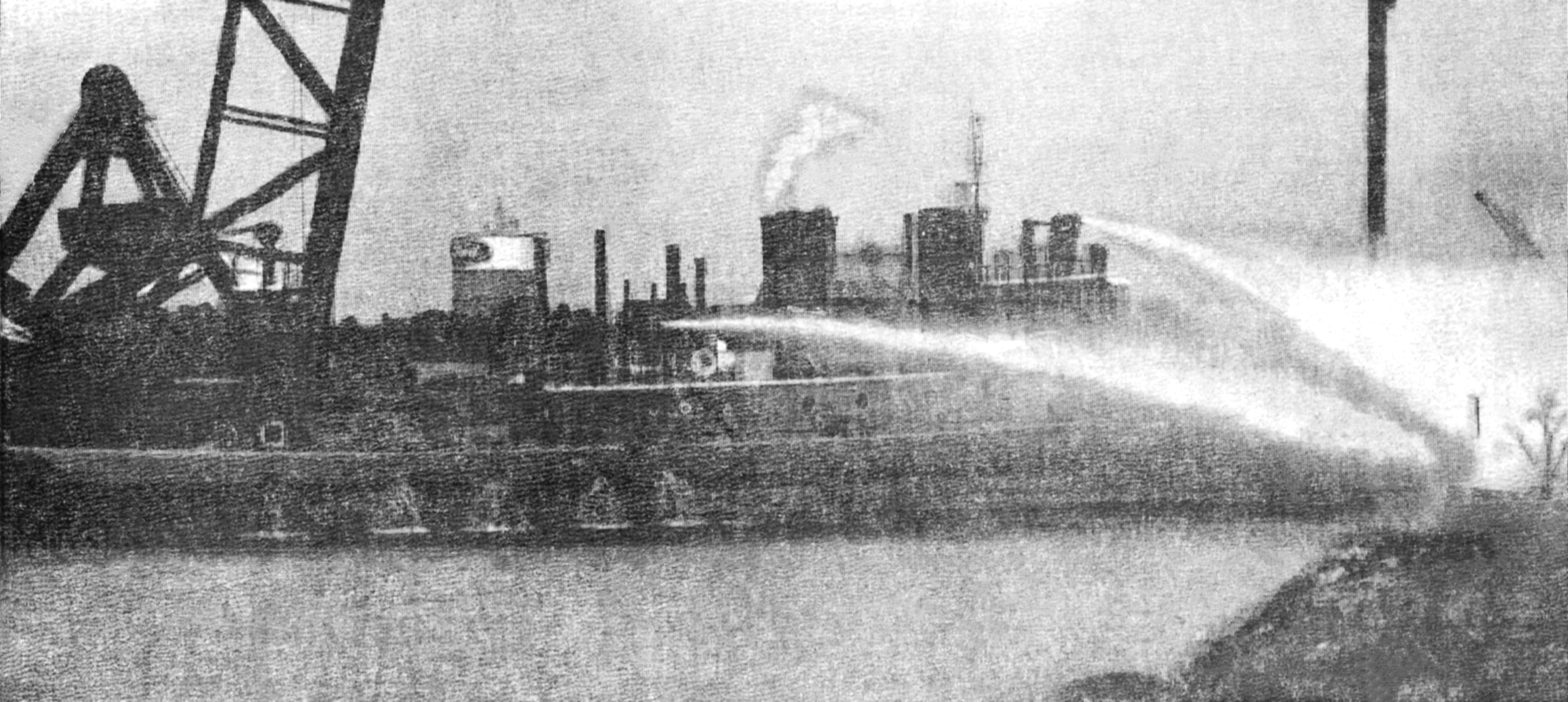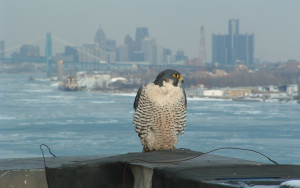
Great Lakes Moment is a monthly column written by Great Lakes Now Contributor John Hartig. Publishing the author’s views and assertions does not represent endorsement by Great Lakes Now or Detroit Public Television.
Fifty years ago this month on October 9, 1969, the Rouge River caught on fire. Smoke billowed over the river that October morning, about 1,000 feet downstream from the I-75 freeway bridge near the City of River Rouge boundary with southwest Detroit.
Floating oil and oil-soaked debris on the north bank of the river were on fire. Detroit firefighters, who extinguished the blaze, estimated that flames shot 50 feet into the air. The cause of the fire was sparks from an acetylene torch that ignited the debris.
To fight and contain the fire, the Detroit Fire Department deployed 10 pieces of equipment and 65 men. However, it was the Detroit fireboat John Kendall that quickly brought the blaze under control. It was reported that shortly before the blaze started a gasket on an oil pipe broke, allowing furnace oil to escape from the Shell depot. Some of it was pumped into a truck. Wind helped spread the remainder of the oil across the river. The U.S. Coast Guard had been called to the scene before the fire started to position oil containment booms to keep floating oil from spreading.
However, despite these U.S. Coast Guard efforts, the oil spread out across the river and caught on fire. The flames spread upstream and stopped at a culvert about 500 feet from the origin of the fire. The U.S. Coast Guard had to halt traffic on the river. In an Oct. 12, 1969, editorial, the Detroit Free Press had this to say about the Rouge River fire:
When you have a river that burns, for crying out loud, you have troubles. It happened on Cleveland’s Cuyahoga, and now it has happened on the Rouge River.
When most people think of burning rivers, they think of the Cuyahoga River in Cleveland, Ohio. It caught on fire on June 22, 1969, less than four months before the Rouge River caught on fire. The 1969 Cuyahoga River fire, like the 1969 Rouge River fire, received relatively little local news coverage. However, the Cuyahoga River fire came precisely at the right time when the national media began to cover the environment as a serious issue and just as there was growing national public recognition of the urgent need to protect the environment.
Time magazine’s August 1, 1969, issue was one of the most widely read issues at a time when access to news was more limited than it is today. It was the week after Apollo 11 returned from its mission to the moon and the magazine featured this historic flight. It was also the first issue with a new environment section, with the Cuyahoga River as its focus. It is fair to say that the Rouge and Cuyahoga river fires in 1969, the Buffalo River fire in 1968, the Santa Barbara oil spill of 1969 and other environmental crises helped awaken the nation to widespread environmental degradation.
These river fires and other environmental disasters became national symbols of industrial indifference and the weakness of public regulation. The public outcry over these river fires and other polluted waterways helped lead to the passage of the 1970 National Environmental Policy Act, the 1972 Clean Water Act, the 1972 U.S.-Canada Great Lakes Water Quality Agreement, and the 1973 Endangered Species Act.
These laws and agreement helped regulate and control water pollution and encourage voluntary pollution prevention initiatives. Since 1985, over $1 billion has been spent on sewer improvement projects and controlling combined sewer overflows that discharge raw and partially treated sewage to the Rouge River during heavy rainfall events. Approximately 396,000 cubic meters of contaminated sediment have been remediated at a cost of $62.8 million and nearly $7 million of habitat rehabilitation and enhancement projects have been implemented in the watershed.
These cleanup and rehabilitation efforts have resulted in considerable river improvements.
In 1969, when the Rouge River caught on fire, oil slicks were common on the lower river, hydrogen sulfide (the smell of rotten eggs) was off-gassing from the river because there was no oxygen in the river, county health departments had to ban human contact with the river because there was so much raw sewage being discharged into it, and even pollution-tolerant carp were dying in the lower river because of no oxygen.
Today, oxygen conditions have improved, fish are returning, peregrine falcons have returned at the river mouth, and the river is being rediscovered as a recreational resource.
In 1969, the Rouge River was perceived as a working river that supported industry and commerce. Water pollution and the 1969 fire were just part of the cost of doing business.
Today, the Rouge River is seen an ecological and community asset that provides many ecosystem services and beneficial uses that enhance quality of life.
Despite these improvements in the Rouge River, some significant challenges remain, including remediating the legacy of industrial pollution in contaminated sediments and brownfields, controlling runoff from the land, rehabilitating and conserving habitats and biodiversity, controlling invasive species, and addressing climate change. For example, 23 percent of the Rouge River watershed is impervious surface that causes both significant runoff problems and loss of habitat.
Research has shown that watershed health begins to decline when impervious surface, such as roof tops, roads, parking lots, coverage exceeds 10 percent and becomes severely impaired if this number climbs beyond 30 percent of the total watershed area. The Rouge River watershed is 23 percent impervious surface. Clearly, more needs to be done to restore wetlands, rehabilitate habitats, build green infrastructure and create more sustainable communities.
The Rouge River has been a leader in use of an ecosystem approach on a watershed scale. It is the first watershed in the United States to have all 48 watershed communities with a stormwater permit.
We must remember that all people who live in this watershed are part of the Rouge River ecosystem and what they do to their ecosystem they do to themselves. Further, all must do their part and be stewards of the place they call home.
It is indeed amazing to think that the Rouge River was once the most polluted river in Michigan and one of the most polluted rivers in the United States. The Rouge River has risen like phoenix from the ashes of a burning river to overcome numerous obstacles and achieve surprising environmental improvement and ecological revival.
This not only gives much to be proud of for the people of the Detroit Metropolitan Area, but it gives a shining example of urban river revival that serves as a beacon of hope throughout the world.
Featured image: The fireboat John Kendall fighting the fire on the Rouge River on Oct. 9, 1969. Photo from the River Rouge Herald, courtesy of the River Rouge Historical Society.
—————————————————————————————————————————————————————————————
Great Lakes Now Contributor John Hartig is a board member at the Detroit Riverfront Conservancy. He serves as the Great Lakes Science-Policy Advisor for the International Association for Great Lakes Research and has written numerous books and publications on the environment and the Great Lakes. Hartig also helped create the Detroit River International Refuge, where he worked as the refuge manager until his retirement.
1 Comment
-
This article is the first one that I have read in Great Lakes Now. I was disappointed that the research referenced in the article (that watershed health begins to decline) was not footnoted.





